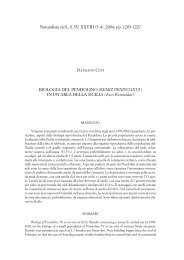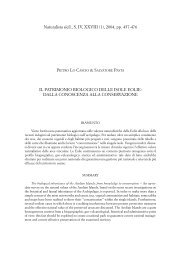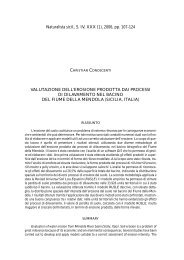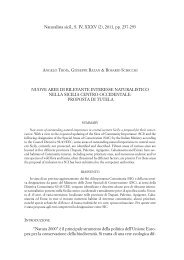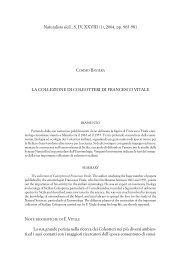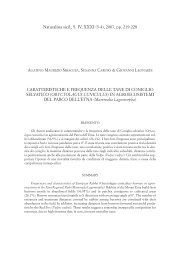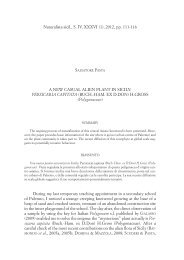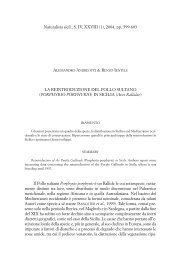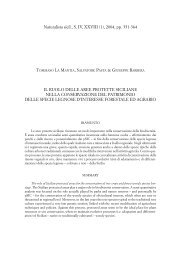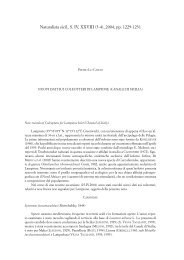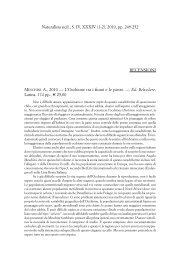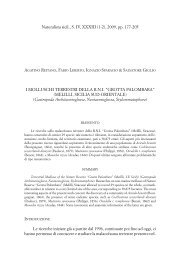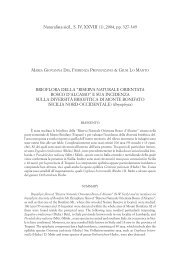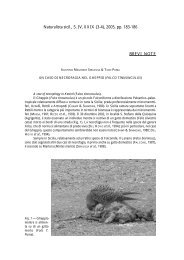2007,pp - Società Siciliana di Scienze Naturali
2007,pp - Società Siciliana di Scienze Naturali
2007,pp - Società Siciliana di Scienze Naturali
You also want an ePaper? Increase the reach of your titles
YUMPU automatically turns print PDFs into web optimized ePapers that Google loves.
Gall midges (Diptera Cecidomyiidae) of Sicily<br />
291<br />
STEFANI (1903, 1906c), TROTTER & CECCONI (1900-1917: N. 11); DE STEFANI<br />
jr (1942) reported galls from Real Favorita (Palermo) on Lathyrus articulatus<br />
L. and L. clymenum L.<br />
Inflorescences changed in rounded terminal galls caused by a<br />
Cecidomyiidae. References: DE STEFANI (1903, 1906c), TROTTER & CECCONI<br />
(1900-1917: N. 12).<br />
Quercus ilex L.<br />
Small galls of about 1 mm size, situated near the leaf vein, caused by<br />
Contarinia sp. Reference: DE STEFANI (1906c).<br />
Vicia dasycarpa Ten.<br />
Leaflet galls just thickened and folded, inclu<strong>di</strong>ng 4-5 small yellowishwhite<br />
larvae, caused by Dasineura sp. (as Perrisia sp.), found at Real Villa<br />
Favorita in April-May. References: DE STEFANI (1903); TROTTER & CECCONI<br />
(1900-1917: N. 28). Flower bud galls caused by Dasineura sp. (as Perrisia sp.),<br />
containing 4-5 yellow larvae. Reference: DE STEFANI (1905c).<br />
ZOOGEOGRAPHY<br />
The gall midge fauna of Sicily may be <strong>di</strong>vided, on the basis of a zoogeographical<br />
analysis, accor<strong>di</strong>ng to the occurrence of species in the Palaearctic<br />
region, into seven groups. The majority, 42 species (48%) are Me<strong>di</strong>terranean,<br />
22 species (25%) European and 11 species (13%) Eurosiberian. Five gall<br />
midge species occurring in almost all the world may be considered to be cosmopolitans.<br />
Among them Aphidoletes aphi<strong>di</strong>myza and Feltiella acarisuga, both<br />
predacious species, are true cosmopolitans, whereas Contarinia pyrivora,<br />
Dasineura mali and Dasineura pyri are secondary cosmopolitans, because origin<br />
centres overlap with their host plants in southern Europe. Hori<strong>di</strong>plosis ficifolii<br />
and Procontarinia matteiana are Asian species associated with host plants<br />
originated from Asia. Contarinia citri, Dicro<strong>di</strong>plosis pseudococci and Lesto<strong>di</strong>plosis<br />
aoni<strong>di</strong>ellae are Afrotropical species. We consider these five last species as<br />
alien for Sicilian fauna, being imported in Sicily probably with plant materials.<br />
Me<strong>di</strong>terranean species are associated with Me<strong>di</strong>terranean host plant<br />
species that have centres of origin in the Me<strong>di</strong>terranean area. To this group<br />
belong eleven species of the genus Asphondylia; Dasineura oleae, Resseliella<br />
oleisuga, Lasioptera berlesiana and Asynapta furcifer associated with olive tree;<br />
Dryomyia lichtensteinii, Contarinia ilicis, C. minima and Arnol<strong>di</strong>ola tympanifex<br />
associated with Quercus ilex and Q. suber; Braueriella phillyreae and



